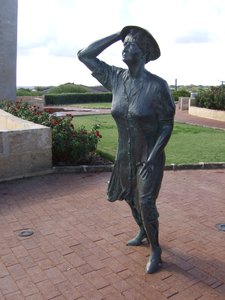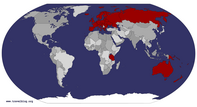Advertisement

 'The Waiting Woman'
'The Waiting Woman'
but the sons, husbands and fathers never came homeMonday 16th – Our departure from Cervantes was very low key. The night had been quiet and we were up at about 8:00am to get ready to leave. Graham had put some things away last night so we were soon packed and ready to go by 9:00am. Vietnam man and his wife, Bob and Jan, were similarly prepared and we followed them out of the park. We were headed for Geraldton 260 kilometers away although we thought we might consider Dongara as we passed through, about 60 kilometers short of Geraldton. Vietnam man had nowhere in mind – they would just drift and settle when the time was right. We followed them as far as Jurien Bay where we had convinced ourselves they would call in just to see what it was like. They hadn’t moved their motor-home all the time they were in Cervantes so we thought they would want to explore. But no – they carried on past Jurien Bay at a fairly modest pace so eventually we passed them and waved them farewell. We drove on for about another 90 minutes or so and reached the outskirts of the twin towns of Port Denison and Dongara, passing by
one of the caravan parks as we approached the ocean front. It looked a nice park but it was still quite early to consider booking in so we parked by the water front and had a break. The weather was fine and if we had chosen to stay there I feel we would have been quite content for a night or two.
But we decided to drive on and went out through Dongara to get to the main highway again. As we reached the main road we recognized the spot where we had come to a grinding halt 8 years ago in need of attention from the RAC. We had been traveling in the opposite direction then but, at a point a few kilometers before we reached Dongara, all of the warning lights on the dashboard of our little camper van had come on. Graham had checked the handbook and guessed what might have happened – the fan belt had gone – but as we were in the middle of nowhere and everything appeared to be working, he decided to chance driving on to Dongara where we could get it looked at. Approaching Dongara he had signalled to turn

 Cyclists struggling along the stretch of road works
Cyclists struggling along the stretch of road works
We passed about 20 cyclists strung out along the road who must have been in some sort of raceright but he found we had NO BRAKES! Luckily we were able to drift to the side of the road, the very spot we were now at with PIE and Sweetie, and to call RACV for help. Within minutes a mechanic was on hand to confirm that the fan belt had broken. Within a few more minutes he had returned to his workshop, acquired a suitable replacement, and had fixed it. We were back on the road within no more than 15 minutes of making our telephone call – brilliant.
This time we had no such worries although a slightly “wobbly” roo bar has been causing Graham some moments of concern over the last few days. He was sure it was nothing serious – just a nut or two requiring tightening after working loose following our various excursions over gravel roads. So we motored on to Geraldton and soon arrived at our chosen caravan park – Belair Gardens which we stayed at last time. Unfortunately, as we arrived so did a horrendous rain storm. We watched as the couple from the caravan in front of us walked back the short distance from the reception and got absolutely soaked before
they could reach their car. We hung on for a while and waited for the rain to subside and then we checked in for three nights. We commented on the disappointment with the weather but the lady in reception was thrilled with so much rain and she hoped we’d get more in the next few days!! Fortunately we were able to set up the caravan in the dry and the facilities were within easy walking distance so if the weather was inclement we would be fairly handily placed. We went for a quick tour of the town (last time we had virtually stayed and moved on) did some shopping and filled up with reasonably priced fuel. Heavy rain came and went frequently so we decided to leave any further adventures until tomorrow and we settled in for the night – dodging yet more heavy rain to use the showers. But we were dry and comfortable and had an early night anticipating some sight seeing tomorrow.
Tuesday 17th started a bit brighter but not before regular heavy downpours during the night and well into the early hours. I had hoped to get some washing done but there was a steady
stream of people heading to the laundry so I abandoned that idea. After a slow start we drifted into town and found the HMAS Sydney Memorial, one of the few things we did see last time and which had made a big impression on us. It is now considered to be the second most important War Memorial in Australia, commemorating as it does the loss of Australian sailors who died whilst attempting to repel a German warship in 1941. This unique memorial features a silver dome of 645 seagulls – one for each sailor who tragically lost his life when the ship was sunk. There were no survivors. The memorial was no less impressive this time although further development work meant that not all of the site was accessible. The last and ‘fifth element’ - a special ‘Pool of Remembrance’ - is being constructed to reflect the discovery, only three years ago, of the wreck of HMAS Sydney in over two kilometers of water 250 kms from Shark Bay. The discovery was enormously important to the relatives of the sailors and helped bring to an end 66 years of mystery. The memorial is one of those special places that most
visitors find very moving.
We drove out of town in a northerly direction along a Coastal Tourist Drive and discovered several attractive parks, one including the remains of a lighthouse. Returning into town, our next stop was the Information Centre where one of the assistants was very anxious to help. She supplied us with an excellent map of the area and a few ideas of places to visit. Earlier that morning Graham had been chatting to our neighbour and noticed they had a slightly more substantial fly screen which they said they had bought from Bunnings. Now armed with a map with the store marked on it, we were soon there and purchasing the new screen and some Velcro to fix it. By now the morning was nearly over so we drove back to the CP for an early lunch which also gave me the opportunity to get the washing done. Graham unwound the new screen and put it up – on its own it was only marginally better than the multi coloured ribboned one we already had but the two together made quite a barrier (we hope) against flies and mosquitoes.
With the washing drying on the
line we set off again and headed for the museum. I had particularly wanted to visit this museum to complete the story which I had started in the Fremantle Maritime Museum about the Batavia, a Dutch trading ship that had hit rocks in 1629 and sunk near the Abrolhos Islands, about 60 kms from Geraldton. I persuaded Graham to come in as well and I think he enjoyed the visit as much as I did. We wandered through to the section which concentrated on ship wrecks that had occurred in the area and in particular the Batavia. One of the ladies in reception gave a very good short talk about why the Batavia happened to be in Australian waters and what had become of the 250 or so crew that had survived the shipwreck. Many of the articles that had been salvaged were of considerable wealth and some were on display. As well as coinage and expensive spices, it included a large amount of stonework that was intended to be used as an archway at the entrance of a wealthy settlement in Indonesia (formerly Batavia).
In a separate room were displays and information about the sinking of HMAS Sydney
and eventual discovery of the whereabouts of the wreck. Letters from a couple of the crew were also on show which brought home the tragedy – Able Seaman William Smith wrote home saying how he was looking forward to seeing his new-born daughter but sadly he never did.
The main room told the story of how the first European pioneers came to the area and the struggle they had to survive. There were also stories of what happened to some of the local Aboriginal people – some were treated well but most, of course, were not.
Outside, in the marina, was a lifesize replica of the longboat used by 48 survivors from the Batavia, as many as the longboat could carry. In June 1629 they sailed 1500 nautical miles to Jakarta, Indonesia to get help. Miraculously, after three and a half months, they returned to the very spot where the remaining men had been left behind. They found that most of them had survived but had broken up into rival factions, one of which was made up of a group of mutineers who had intended taking over the Batavia and had been foiled only by it sinking. The “good”
guys were rescued but the mutineers were left to their fate on the islands and no-one really knows what happened to them. Aboriginal “talk” was that some of them made it somehow to the mainland and integrated with the aborigines in the area but no historical records of this exist.
From the museum we strolled past the marina and along the “front”. The Geraldton Council is trying hard to make the front tourist friendly and they seem to be making a good job of it. There’s a long way to go yet but it’s beginning to take on a holiday feel which is quite an achievement given that Geraldton is the main industrial centre for the area and also a major lobster fishing port. We continued along the Coastal Tourist Drive past our caravan park to the south of Geraldton. We drove past a working lighthouse and, as before, we discovered quite a lot of interesting parks, most with beaches and some within easy walking distance of the caravan. After about 8 kilometers we reached the main highway so made our way back to the caravan. Graham went for a walk/jog and I sorted what had become a huge
pile of clean and dry washing before we settled in for the night.
Advertisement
Tot: 0.118s; Tpl: 0.015s; cc: 13; qc: 27; dbt: 0.0823s; 1; m:domysql w:travelblog (10.17.0.13); sld: 1;
; mem: 1.1mb




















Keith and Gill
non-member comment
Familiar pictures
Hi We have similar photos from our trip to Geraldton last year, so brings back memories. Our time there though was baking hot - sorry. Although 42 deg was a little too hot. Happy travels Love G & K